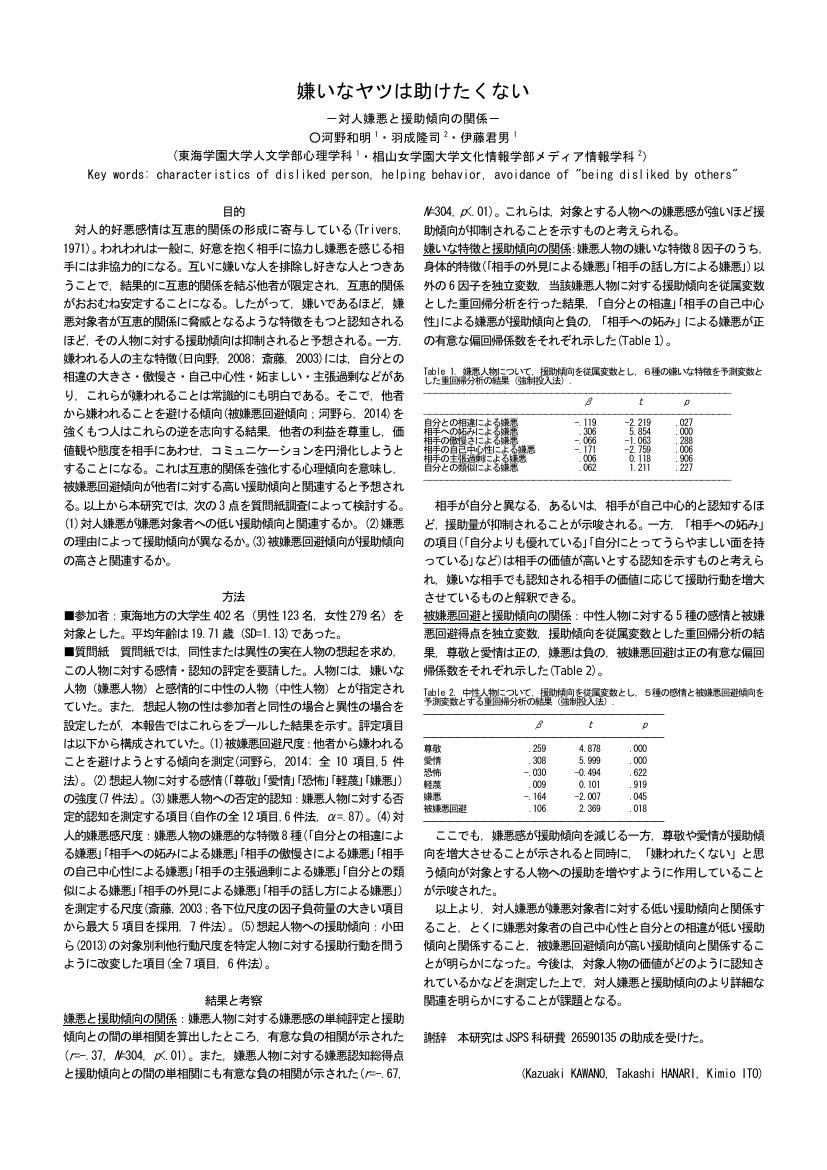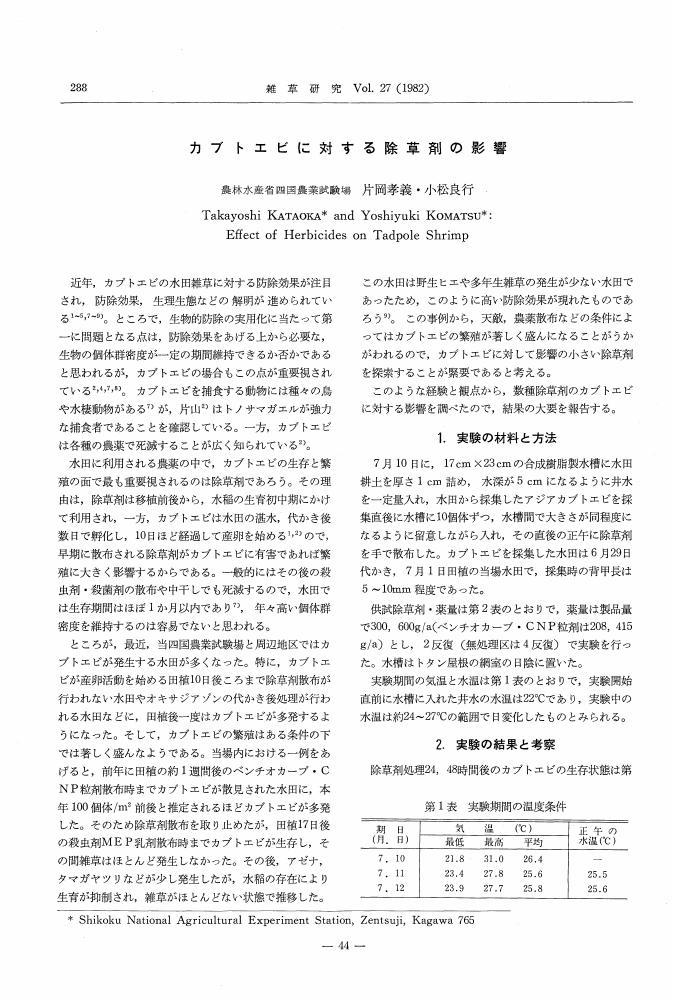2 0 0 0 IR イスタンブル・レポート : 2010~2011年
- 著者
- 伊吹 裕美
- 出版者
- 専修大学人文科学研究所
- 雑誌
- 専修大学人文科学研究所月報 (ISSN:03878694)
- 巻号頁・発行日
- no.255, pp.29-73, 2012-01
2 0 0 0 OA オットセイ漁規制に対する仕方なさの奥行き : 大槌町赤浜地区の漁業者の語りを中心に
- 著者
- 吉田 静 ヨシダ シズカ Shizuka Yoshida
- 雑誌
- 社会学研究科年報
- 巻号頁・発行日
- vol.25, pp.81-86, 2018
2 0 0 0 OA 嫌いなヤツは助けたくない
- 著者
- 内藤 まりこ
- 出版者
- 物語研究会
- 雑誌
- 物語研究 (ISSN:13481622)
- 巻号頁・発行日
- vol.7, pp.1-13, 2007
In this paper by focusing on a topic, Shiga no yamagoe, the author considers the dynamics of medieval poetry. A striking feature of the poems composed on the set topic Shiga no yamagoe in the Roppyakuban utaawase (1193) is that all of them included the phrase "Flower". Previous researchers have argued that there was a strong connection between Shiga no yamagoe and the phrase "Flower" in medieval poetry, even though the reason for this connection remained uncertain. How then did flowers come to be associated with Shiga no yamagoe? The author begins with discussing what led Shiga no Yamagoe to be linked with the idea of flowers. First, the author examines how Fujiwara no Shunzei, the judge of the Roppyakuban utaawase, supported the notion of combining Shiga no yamagoe with spring flowers in poetry composition. Secondly, the author shows how some poems pair flowers with the idea of female pilgrims traveling to Shiga Temple. The author argues that there were narratives about women pilgrims going to Shiga Temple which supported the relationship between Shiga no yamagoe and women. And the author also shows that the actual pilgrimage to Shiga Temple was no longer practiced by Shunzei's time. The author suggests that the association of Shiga no yamagoe with the idea of flowers developed from narratives of female pilgrims set in the past. In addition, the author focuses on a famous place. or utamakura, Shiga no hanazono, which appeared in medieval times for the first time. The author argues that it was a fictional place, which created whereby the topic Shiga no yamagoe came to be associated with flowers.
- 著者
- 陶山 裕有子
- 出版者
- 物語研究会
- 雑誌
- 物語研究 (ISSN:13481622)
- 巻号頁・発行日
- no.9, pp.1-11, 2009-03-31
This study considers the "classic intellect" in the Insei period and discusses historical description within two texts, Okagami and the Imakagami, neither of which cites classic literature. I investigate the "classic intellect" within three waka textbooks: Kokinjochu by Katsumyo, Fukurozoshi, and Toshiyorizuino. In these textbooks, secret poetic principles are written in reference to waka language from Kokinshu, which had already become a "classic" within waka circles. In the Kokinjochu, for example, waka theory is explained in reference to Nihongi, which had nothing to do with waka. Many people in the Insei period collected and put together classic books (books about classical literature?), which is why intellectuals referred frequently to the "classic intellect." This study shows that Okagami and Imakagami, which were written in the same period, did not use the phrase "it was written in" but rather "I heard that it was written in," even if directly using the classics. Further, I show that the narrator of these texts states that anyone, including the illiterate, can understand historical description-a claim which is incompatible with the notion of the "classic intellect" being understandable only by intellectuals.
- 著者
- 野口 竜也 窪田 彰夫 西田 良平
- 出版者
- 地震予知総合研究振興会東濃地震科学研究所
- 雑誌
- 東濃地震科学研究所報告
- 巻号頁・発行日
- no.19, pp.1-7, 2006-11
2 0 0 0 OA カブトエビに対する除草剤の影響
2 0 0 0 1361年正平南海地震に対応する東海地震の推定
- 著者
- 石橋 克彦
- 雑誌
- 日本地震学会講演予稿集 = Programme and abstracts, the Seismological Society of Japan
- 巻号頁・発行日
- vol.1998, no.2, 1998-10-09
- 被引用文献数
- 1
2 0 0 0 OA カール・シュミットとドノソ・コルテス (1) : シュミットのドノソ・コルテス体験
- 著者
- 古賀 敬太 コガ ケイタ Keita KOGA
- 雑誌
- 聖隷学園聖泉短期大学人文・社会科学論集
- 巻号頁・発行日
- no.3, pp.1-58, 1988-12-20
- 著者
- 茂木 有希子
- 出版者
- 三輪書店
- 雑誌
- 地域リハビリテーション (ISSN:18805523)
- 巻号頁・発行日
- vol.5, no.6, pp.528-531, 2010-06
2 0 0 0 OA 速成柔術講義録 : 附・秘伝死活法
2 0 0 0 OA 一九四〇年代の在台日本人の郷土意識 ――池田敏雄の台湾民話を例として――
- 著者
- 莊 千慧
- 出版者
- 日本文学協会
- 雑誌
- 日本文学 (ISSN:03869903)
- 巻号頁・発行日
- vol.64, no.9, pp.50-60, 2015-09-10 (Released:2020-10-03)
一九四〇年代の台湾では、日台両方とも〈郷土〉に対する概念の変化が見られる。本論では、池田敏雄という在台日本人の台湾民話に着目し、歴史状況の葛藤の現場として池田の活動を捉える。一九四〇年代の日台の文化的交渉の錯綜を具体的に示すものとして、池田とその民話を提示し、池田民話の再評価を試みる。
2 0 0 0 OA 聴覚過敏と暮らしの音環境
- 著者
- 佐久間 哲哉
- 出版者
- 一般社団法人 日本音響学会
- 雑誌
- 日本音響学会誌 (ISSN:03694232)
- 巻号頁・発行日
- vol.77, no.5, pp.296-301, 2021-05-01 (Released:2021-06-01)
- 参考文献数
- 15
2 0 0 0 特別インタビュー 職業は「長嶋茂雄」
2 0 0 0 OA CEFRに基づいた初級漢字タスク集の開発(第29回研究会,1.研究発表)
- 著者
- 稲垣 厚子
- 出版者
- JSL漢字学習研究会
- 雑誌
- JSL漢字学習研究会誌 (ISSN:18837964)
- 巻号頁・発行日
- vol.3, pp.22-27, 2011-03-31 (Released:2017-05-26)
- 参考文献数
- 21
本漢字教材は、欧州の非漢字系日本語学習者を対象として、CEFRのA1,A2,B1レベルの「読み」「書き」技能における漢字の取り扱いを明確にし、学習者が漢字の運用力を自己評価できるようになることを目的とする。学習者は、CEFRのCDSに準拠したタスクを通して実生活で漢字を使って何ができるかを認識し、自己の学習段階を診断することができる。これによって新たな学習の動機付けにもつながると考えられる。
2 0 0 0 IR 歴史学者谷森饒男と芥川龍之介 : 第一高等学校時代の交友と文学
- 著者
- 高重 久美
- 出版者
- 大阪市立大学国語国文学研究室文学史研究会
- 雑誌
- 文学史研究 (ISSN:03899772)
- 巻号頁・発行日
- no.57, pp.68-82, 2017-03
牛込区弁天町の谷森饒男に芥川龍之介が田端から送った葉書がある。『芥川龍之介全集』岩波書店 : 第十七巻書簡I ─ 第二十巻書簡IV(第二刷二〇〇八年五月-八月)、第二十四巻書簡補遺(同一二月)に未収録で、『芥川竜之介書簡集』(石割透編 : 岩波書店 : 2009年10月)の37、古書目録(平成20年12月)に掲載された写真版からの翻刻によって知られる。管見の限りでは、芥川と谷森の交友について論じた先行研究はない。……
2 0 0 0 OA 一般的信頼と信頼性判断
- 著者
- 小杉 素子 山岸 俊男
- 出版者
- 公益社団法人 日本心理学会
- 雑誌
- 心理学研究 (ISSN:00215236)
- 巻号頁・発行日
- vol.69, no.5, pp.349-357, 1998-12-25 (Released:2010-07-16)
- 参考文献数
- 28
- 被引用文献数
- 27 25
Contrary to the common sense idea that trustful people are gullible and easily believe whatever other people may say, past research reviewed by Rotter (1980a) indicated the idea was not necessarily valid. Two experiments of this paper further demonstrated that trustful people are more sensitive to information that indicates lack of trustworthiness in other people. In the experiments, subjects read a series of stories in which a person was about to make a choice between a trustworthy action and an untrustworthy one. Some of them were also given pieces of information regarding trustworthiness of the person. They were then asked to predict the likelihood of the person taking a trustworthy action. When no information was given, high trusters predicted with higher probability than low trusters that the person would take a trustworthy action. On the other hand, the high trusters lowered the predicted likelihood more steeply than the low when negative information was provided.



